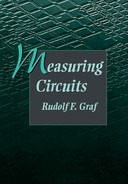Tachometer Circuits
The sources of the following circuits are contained in the Sources section, which begins on page 217. The figure number in the box of each circuit correlates to the source entry in the Sources section.
LOW-FREQUENCY TACHOMETER
This tachometer lets you measure heartbeats, respiratory rates, and other low-frequency events that recur at intervals of 0.33 to 40.96 seconds. The circuit senses the period of fIN, computes the equivalent pulses per minute, and updates the LCD accordingly. Although the decimal readout equals 60 fIN, the circuit doesn’t actually produce a frequency of 60 fIN. The computation involves counting and comparison techniques and takes 0.33 seconds.
TACHOMETER
A standard shaft encoder’s A and B ports generate square waves with the same frequency as the shaft turns. The phase of A will lead or lag that of B by 90°, depending on the direction of rotation. To obtain maximum resolution, the tachometer circuit must count every change of the state for the A and B signals. Each such change causes a change of state at IC1A’s output, followed by a 1-µs negative pulse at the output of IC1C. These clock pulses’ positive (trailing) edges cause the counter to count up or down, according to the direction of shaft rotation.
You should set the R1C1 time constant so that it is approximately twice that of the R2C2 product, to ensure adequate setup and hold times for the up/down signal with respect to the positive clock edges. IC1C supports this timing requirement by producing clock pulses of similar duration for either positive or negative transitions or IC1A.
The exclusive-NOR logic of IC1B generates the correct polarity of the up/down signal when necessary, at the positive clock edges, by combining the A value with the B value just prior to a transition of A or B. C1 provides memory by sorting the ? value voltage for about 2 µs. The maximum frequency for A or B is approximately (4R1C1)−1.
CALIBRATED TACHOMETER
Here is a simple tachometer circuit for use with a hand-held DVM or portable chart recorder. A novel feature is that the source frequency pulse/rev rate can be directly set on a 10-turn potentiometer to provide a convenient calibration of 1 V per 1000 rev/min. This is particularly useful when measuring a shaft or engine speed by sensing the gear teeth.
The circuit uses an LM2917IC, which is specifically designed for tachometer applications. The 10-turn potentiometer, which provides the pulse/rev setting, is suitably configured in the output amplifier feedback path. The pulse/rev range is 100 to 1100, so the potentiometer dial mechanism should be set to start at 100 to provide direct calibration.
The IC’s internal 7.5-V zener provides stable operation from a 9-V battery. The tachometer accepts an input signal between 50 mv and 20 V rms and has an upper speed limit of 6000 rev/min with the component values shown.



